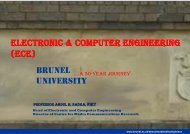DEliverable 2.3 - the School of Engineering and Design - Brunel ...
DEliverable 2.3 - the School of Engineering and Design - Brunel ...
DEliverable 2.3 - the School of Engineering and Design - Brunel ...
You also want an ePaper? Increase the reach of your titles
YUMPU automatically turns print PDFs into web optimized ePapers that Google loves.
ICT Project 3D VIVANT– Deliverable <strong>2.3</strong><br />
Contract no.:<br />
248420<br />
User Acceptance Validation Plan<br />
horizontal disparity range have to be adjusted to follow <strong>the</strong> artistic intention <strong>and</strong> technically result in<br />
good stereoscopic images without distortions. These adjustments are typically controlled via a<br />
monitor capable <strong>of</strong> showing stereoscopic content. For 3D holoscopic image production, it has to be<br />
investigated if similar or o<strong>the</strong>r depth related parameters are relevant <strong>and</strong> how <strong>the</strong>se parameters can be<br />
controlled <strong>and</strong> monitored. A 3D holoscopic display for image control will be necessary. Referring to<br />
signal parameters like white level, black pedestal, gamma <strong>and</strong> component gain in 2D <strong>and</strong> stereoscopic<br />
productions, measurement instruments like waveform monitor <strong>and</strong> vectorscope are used. These<br />
instruments will also have to be adapted to suit holoscopic content.<br />
3.2 PRODUCTION PROCESSES<br />
The production <strong>of</strong> <strong>the</strong> service scenarios in <strong>the</strong> use cases including 3D holoscopic content <strong>and</strong><br />
hyperlinked video will have implications for <strong>the</strong> production process <strong>and</strong> will to some extent require<br />
new or altered tasks, skills <strong>and</strong> workflows for <strong>the</strong> whole production team. It is, <strong>the</strong>refore, planned to<br />
conduct interviews <strong>and</strong> create focus groups with key members <strong>of</strong> <strong>the</strong> production teams at RBB <strong>and</strong><br />
RAI to ga<strong>the</strong>r guidelines <strong>and</strong> recommendations. Annex 2 lists <strong>the</strong> differences between 2D <strong>and</strong> 3D<br />
stereoscopic production <strong>and</strong> contains production guidelines for 3D stereoscopic production. This<br />
document, provided by ARRI, is based on in-house experience <strong>and</strong> also on an interview with <strong>the</strong><br />
director <strong>of</strong> photography (DOP) Christian Rein, who is experienced in shooting 3D stereo. These<br />
guidelines could provide <strong>the</strong> basis for discussions with <strong>the</strong> production team. The main issues will be:<br />
• Storyboard, film production grammar – How did <strong>the</strong> depth cues in 3D holoscopy affect <strong>the</strong><br />
storyboard, specifically: How much depth should be contained in each scene What is <strong>the</strong><br />
interaction between <strong>the</strong> depth cues Was <strong>the</strong>re a Lilliputian effect or anything similar Was<br />
window violation an issue Will an object in front <strong>of</strong> <strong>the</strong> screen, which is close to <strong>the</strong> lateral<br />
frame <strong>of</strong> <strong>the</strong> picture, be cut <strong>of</strong>f by <strong>the</strong> picture frame in an unnatural manner<br />
• Pre-production – Did staging <strong>and</strong> decorations have to be planned <strong>and</strong> built more accurately for<br />
3D holoscopic productions<br />
• Shooting – What additional equipment was needed Was additional personnel required (e.g., in<br />
stereoscopic 3D a stereographer cooperates with <strong>the</strong> DOP <strong>and</strong> <strong>the</strong> director to design <strong>the</strong> depth<br />
perception <strong>of</strong> <strong>the</strong> picture) Did a slower panning speed produce less irritating results Was <strong>the</strong><br />
pace <strong>of</strong> work slower than for 2D production<br />
• Quality control – How did 3D holoscopic production affect quality control<br />
• Editing – Did <strong>the</strong> 3D production require a slower/different pace <strong>of</strong> cutting as well as o<strong>the</strong>r editing<br />
effects<br />
• Green Screen, visual effects – How did 3D holoscopic production affect chroma keying <strong>and</strong><br />
visual effects Typically back plates <strong>and</strong> composites <strong>of</strong> real <strong>and</strong> virtual layers are more<br />
dem<strong>and</strong>ing in 3D. Virtual elements have to be placed at <strong>the</strong> right position in depth in <strong>the</strong> scene.<br />
Moreover, flat back plates might not be sufficient, e.g., when simulating a deep perspective.<br />
• Additional tasks in post-production – What additional tasks were necessary in post-production<br />
01.09.11 17
















